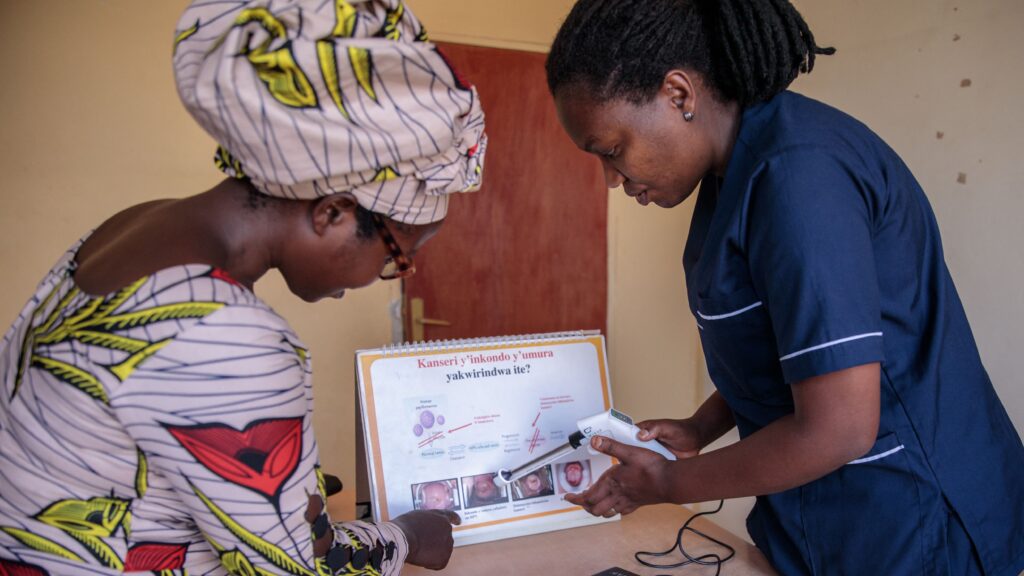A genomic test for the human papillomavirus has shown promise in early-stage trials, raising hopes that it could bolster cervical cancer screening among women living in sub-Saharan Africa, the region with the highest rates of cervical cancer deaths worldwide.
The trials were documented in a study, published Wednesday in Science Translational Medicine, led by researchers from Rice University. The study shows how an HPV DNA test, which is cheaper than many current screening options, could make cervical cancer screening more accessible to women in countries with fewer resources.
“It’s very exciting — they’ve made an important advancement in getting us to a point-of-care test,” said Sarah Finocchario Kessler, a public health researcher and professor at the University of Kansas School of Medicine, who was not part of the research team.
Worldwide, there were 604,000 new cases of cervical cancer in 2020, and 342,000 women died of the disease that year, according to the World Health Organization. About 90% of those cervical cancer deaths occurred in low- and middle-income countries.
Doctors depend on tests that require robust laboratory infrastructure and skilled medical professionals to screen patients for cervical cancer. One common screening method is the Pap smear, which requires a specialized instrument to remove cells from the cervix to detect precancerous cells. Because Pap smears are expensive, as well as lack of awareness about where to get screenings and concerns over pain and potential embarrassment, uptake has been substantially low among women in South Africa and other developing countries.
There are other screening options, such as visual inspection with acetic acid (VIA), but those have their own drawbacks such as poor sensitivity.
Unlike the Pap smear, the HPV DNA test can be performed by a minimally trained health care professional, using a mini centrifuge in the lab.
“You could run this test in decentralized locations to detect if somebody has high-risk HPV that causes cervical cancer, and then proceed with diagnosis and treatment,” said Kathryn Kundrod, a bioengineer and postdoctoral researcher at Rice University, who led the study.
The Rice University researchers analyzed self-collected cervical swab samples from patients at the University of Texas MD Anderson Cancer Center, looking for HPV16 and HPV18 genotypes — the two most common HPVs, which are responsible for 70% of all cervical cancer cases.
The researchers knew that they needed to see if their test would work in low-resource settings. So, they next transported the tests to Maputo in Mozambique. There, they used self-collected samples from patients at the Hospital Geral de Mavalane to evaluate the test. Their tests screened for cervical cancer within 45 minutes, and showed promising results: 1,000 copies of HPV DNA per test. Another helpful feature of the tests, Kundrod said, is that they display visual results, “like a home COVID test or a home pregnancy test.”
Although the tests have proved successful in screening for cervical cancer in the early-stage trials, some hurdles remain. In Maputo, the researchers found that the tests were less sensitive in samples with low concentration of cervical swabs than in Texas. The tests also showed false negative results in some samples that had extremely high amounts of cells in them.
“We weren’t completely surprised by that, when you’re testing in the same environment that you develop the test, in the same conditions, it’s ideal,” said Kundrod. “But if we were to go anywhere else, outside of our controlled lab setting, we would expect slightly different results.” She said that they hope to address the problem in upcoming studies.
But that’s not the only problem the tests must overcome if they’re to be deployed in the regions most affected by cervical cancer. They also need to be even faster.
In many sub-Saharan African countries, clinics are understaffed and often have long queues of women waiting to be screened by doctors. “I think that would really threaten the value of a point-of-care test,” said Kessler, who has worked in several African countries since 2010.
Kundrod told STAT that her team plans to further optimize the test by integrating what they learned from Mozambique. They also hope to include additional HPV genotypes. “We’ll use those findings to refine our protocol and make sure that the DNA from the samples is detectable reliably and consistently, regardless of the cellular content of those samples,” she said.


